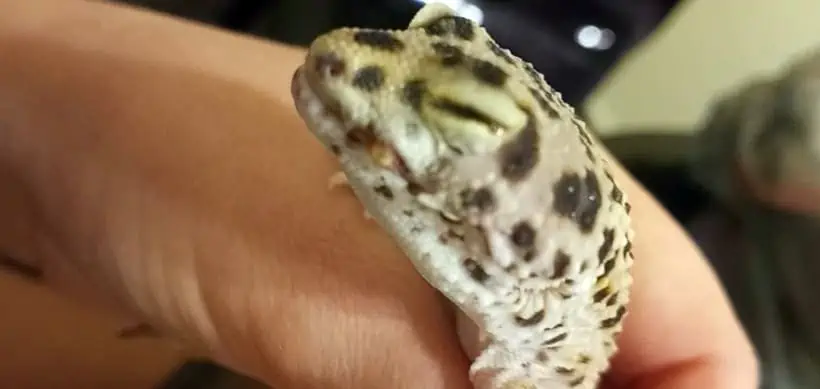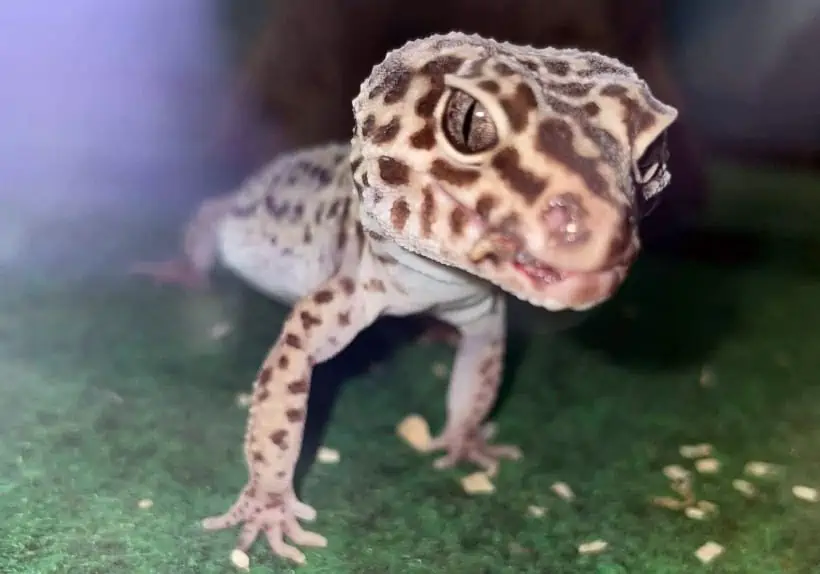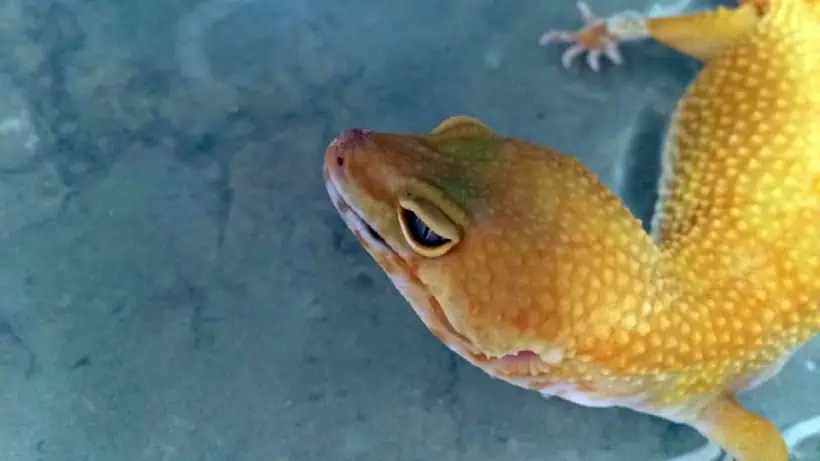We all dread the day we’ll see that something is wrong with our pets’ health – and mouth rot is an issue that is usually quite traumatic to witness
All animals can get sick, including the captive ones. Although leopard geckos are particularly hardy pets, they still can suffer from an illness – especially if they live in inadequate conditions.
Mouth rot is one condition that is commonly connected with bad keeping conditions, but it is not all that is
As a loving and responsible leopard gecko owner, at this point, you’re probably wondering:
- Why does mouth rot happen?
- How do you cure mouth rot in leos?
- How to prevent mouth rot?
If you want to know the answers to these questions – this article is all about mouth rot. We’ll cover why it occurs, How to prevent it, and how best to treat it if it happens.
The topic is certainly not pretty, but fear not – the solutions are out there, and I intend to lay them out for you.
Let’s begin.
What Is Mouth Rot?
Mouth rot, also known by its less graphic medical name infectious stomatitis, is a bacterial infection of the mouth. It can happen to lizards, snakes, and turtles – and leopard geckos are unfortunately not an exception. It is one of the most common leopard gecko mouth problems (if not the most common).
The infection starts when bacteria invade the reptile’s mouth tissue. It is important to note that mouth rot is not caused by some specific pathogen but rather by the overgrowth of bacteria that commonly live in the mouth.
That means that mouth rot occurs when something is wrong with your leo’s immune system, the environment, or both.
How Do I Know If My Leopard Gecko Has Mouth Rot?
In leopard geckos, the symptoms of mouth rot are the same as in other reptiles.
They can include:
- Loss of appetite (the mouth are inflamed, and eating becomes too painful)
- Redness of the lining of the mouth
- Visible puss or dead tissue in the mouth
- Open abscess
- Liquids oozing from the mouth and the nose.
If mouth rot is not treated, it can spread to the rest of the digestive tract (hence the medical name stomatitis) and lungs, causing pneumonia.
The common symptoms of pneumonia in leopard geckos are:
- Mucus or mucus bubbles around the nostrils
- Difficulty breathing

Why Does Mouth Rot Happen?
As with most unspecific bacterial infections, many circumstances can contribute to the development of mouth rot in leopard geckos.
Since mouth rot is caused by bacteria commonly found in the reptile’s mouth, it is an immune dysfunction that enables the infection to occur.
When the immune system is down (which can happen for several reasons, as I’ll discuss below), it can’t keep the number of these germs under control. Overgrown bacteria take their opportunity and start feeding on the reptile’s tissues, causing damage.
The bacteria cause inflammation, and in severe cases, the tissue goes necrotic (hence the term ‘rot’).
So, how can your leo’s immune system become compromised?
In the case of mouth rot, the most common reason is inappropriate (too high) humidity and inadequate temperature.
Also, poor diet, lack of supplementation, and injuries of the mouth can bring on the disease as well.
However, even if you’re doing everything perfectly, an underlying health issue or simply old age can serve as a base for the development of mouth rot.
Feeding Tips to Avoid Mouth Rot
Larger feeder insects such as super worms will try to defend themselves when your leo grabs them. They have strong mandibles (insect jaws) and can bite your gecko. If they grab the mouth tissue – there’s an opportunity for mouth rot development.
That is the reason I crush the head of each superworm with feeding tweezers before offering it to my leo. It is a bit gruesome, but they would get crushed seconds later in the gecko’s mouth anyway – and safe is safe, right?
While I’m at it, the choice of tweezers is crucial to avoid any injuries during feeding if you use them. Always use tweezers specially designed for reptile feeding. Alternatively, you can repurpose plastic toy tweezers (e.g., from toy medical sets), but make sure they have absolutely smooth edges and tips.

How Do You Treat Mouth Rot in Leopard Geckos?
If your leopard gecko is showing the symptoms of mouth rot, the best course of action is is to take him to a specialized reptile vet as soon as possible.
A typical mouth rot treatment usually includes a course of antibiotics and local antiseptic cleaning of the infected area and the entire mouth.
In severe cases, surgery may be required to remove any dead, necrotic tissue.
Leo’s mouth will need some time to heal. In difficult cases, they won’t be able to use their mouth for a while. That means they will also require nutritional support and fluids provided by the vet.
How Do You Prevent Mouth Rot in Leopard Geckos?
Prevention is always better than the cure – and preventing mouth rot is relatively easy if you follow the best leopard gecko keeping practices.
Ensure that the temperature and humidity are always suitable for the species.
Leos do not live in humid areas, so it is essential to ensure that the humidity level doesn’t rise (between 30 and 40% is ideal) and that air circulation is fair.
Also, always make sure to watch over your leopard gecko’s behavior to catch any stress signs early enough – before damage happens.
To Sum It Up
Mouth rot is a common problem in all pet reptiles. However, it cannot occur out of the blue.
Favorable circumstances for mouth rot development include inadequate husbandry, mouth injury, underlying health conditions – or any combination of these factors that will result in immune deficiency.
The best way to prevent mouth rot is to keep your pet leo in the right conditions, with a particular focus on proper nutrition, temperature, and humidity. Ensuring good hygiene is also a must. If an infection does occur, the critical thing is to take your gecko to the reptile vet.
I hope you have enjoyed the article and that now you feel empowered to deal with mouth rot in reptile pets. As you can see, just being a responsible leo owner goes a long way in preventing the conditions?
Did you ever have a pet with mouth rot? What were the first signs, and how did the treatment go? Let us know in the comments!



4 Comments
This article was very helpful, thank you! My son has the sweetest 2 year old Leo, named Argos. About 6 months ago, he stopped eating, and we noticed swelling & redness on his mouth. We took him to the vet, where they confirmed a mouth rot diagnosis. Luckily, we caught it really early. However, they did not prescribe any antibiotics and only sent us home with a topical Silver Sulfadiazine Cream to apply to the infected tissue. It did heal & he was eating again within a few days, but it has unfortunately returned. We still have the ointment & have started applying it already. What would you suggest as far as taking him back to vet – should we go ASAP or wait & see if the ointment is enough? It’s been 2.5 days since he’s eaten anything. He loves the jumbo mealworms, and I’m quite certain they are what caused injury to his mouth. We will now always crush their heads first, thanks to your tip. I do have a couple more questions:
– Do Leos require a vitamin supplement, other than calcium? If so, what do you recommend?
– What are some “softer” feeder insects we could offer Argos? We’ve given him wax worms before & he really liked them, but my son thinks they die off too quickly.
– Is there a certain gentle technique we could use to get him to open his mouth for us, so we can clean & apply the ointment as needed?
We absolutely adore Argos & just want to take the best care of him as possible, so he lives a long & happy life like your Leos are!
Hi Dawn, I hope Argos is doing all better by now and I’m sorry that the reply comes in late. I still hope you’ll find it useful.
As for the treatment, the best thing is to closely follow your vet’s advice, especially since the treatment was successful the first time around. Starting with the same treatment routine again would be a good start. Leos can last without food several weeks, and 2,5 days is nothing to worry about. In fact, adult leos shouldn’t be fed more frequently than 2-3 times per week.
To answer your questions:
– Leos definitely require broader vitamin supplementation – a powdered multivitamin and mineral supplement (with D3) for carnivorous reptiles will do great. Without this combination of vitamins and minerals, a leo will not be able to maintain proper metabolism or immunity, making him more prone to diseases and infections. You can’t go wrong with reputable manufacturers – e.g., ZooMed’s Reptivite with D3 and Repashy Calcium Plus. and similar products from Flukers and ExoTerra are pretty much standard. Sera’s Reptimineral C is also excellent and the one I used the longest (but I’m in Europe).
– As for softer and non-aggressive insects that have good nutritional profiles, leos love small Dubia roaches and silkworms as well. I would recommend avoiding waxworms and butterworms anyway due to their high fat content. Leos love them the same way most of us love bacon 🙂 but to remain healthy, we limit the amounts. The same applies to leos and waxworms.
– Touching the leopard gecko’s nose or “lips” on both sides of the head simultaneously like in this video will usually make them open their mouth – but you have to be quick and precise with applying the ointment! If you’re still having trouble, ask your vet how to approach it. Best of luck!
I am a new pet owner. My leopard gecko is less than one year old.
I had been watching it after impaction due to eating substrates. I attempted the olive oil technique to try to loosen the impaction. I think I may have hurt him when he bit quite hard on a butter knife with a drop of olive oil on it.
Could this cause mouth rot? He has not eaten much since.
Hi Luke,
I hope that your situation has been resolved for the best by now.
It seems to be a complex case, as you can’t be sure if your gecko is not eating because of the impaction or because of the potential injury.
Also, never administer the olive oil with something sharp, or any object that could injure the leo when biting.
Personally speaking – I simply dipped my finger into a bit of oil to get a drop on it, and touched my leo’s “lips.”
In cases like this, I would suggest taking your leo to the reptile vet if possible and monitoring for signs of mouth injury or rot.
Biting down on metal can lead to an injury, but not every injury will become mouth rot. Good luck!